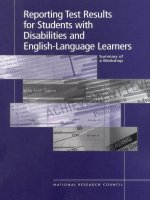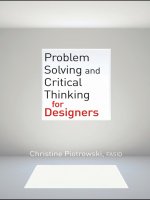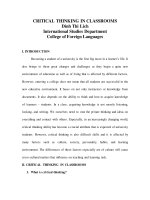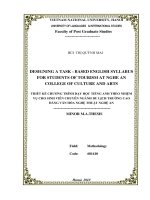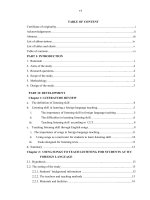67415489 critical thinking for students
Bạn đang xem bản rút gọn của tài liệu. Xem và tải ngay bản đầy đủ của tài liệu tại đây (13.62 MB, 129 trang )
Critical Thinking
for Students
If you want to know how...
Writing an Essay
How to improve your performance in coursework and examinations
Writing Your Dissertation
How to plan, prepare and present successful work
Passing Psychometric Tests
Know what to expect and get the job you want
Critical Thinking for AS Level
Critical Thinking for A2
howtobooks
Send for a free copy of the latest catalogue to:
How To Books
Spring Hill House, Spring Hill Road,
Begbroke, Oxford OX5 1RX, United Kingdom
email:
Critical
Thinking
for Students
Learn the skills of critical
assessment and effective
argument
ROY VAN DEN BRINK-BUDGEN
3rd edition
howtobooks
Published by How To Content,
a division of How To Books Ltd,
Spring Hill House, Spring Hill Road,
Begbroke, Oxford OX5 1RX, United Kingdom
Tel: (01865) 375794. Fax: (01865) 379162
email:
www.howtobooks.co.uk
All rights reserved. No part of this work may be reproduced or stored in
an information retrieval system (other than for purposes of review)
without the express permission of the Publisher given in writing.
The right of Roy van den Brink-Budgen to be identified as the author of this work has
been asserted by him in accordance with the Copyright, Designs and Patents Act 1988.
© Copyright 2000 Roy van den Brink-Budgen
First published in paperback 1996
Second edition 1999
Third edition 2000
Reprinted 2001
Reprinted 2002
Reprinted 2003 (Twice)
Reprinted 2004 (Three times)
Reprinted 2005 (Twice)
Reprinted 2006 (Twice)
First published in electronic form 2007
ISBN: 978-1-84803-018-3
Cover design by Baseline Arts Ltd, Oxford
Produced for How To Books by Deer Park Productions, Tavistock
Typeset by Anneset, Weston-super-Mare, N. Somerset
NOTE: The material contained in this book is set out in good faith for
general guidance and no liability can be accepted for loss or expense
incurred as a result of relying in particular circumstances on
statements made in the book. Laws and regulations are complex and
liable to change, and readers should check the current position with
the relevant authorities before making personal arrangements.
Contents
Preface
7
1
9
2
3
4
Identifying Arguments
Persuading and arguing
Finding arguments
Recognising the importance of arguments
Arguing, explaining and summarising
Matching reasons to conclusions
Exercises
9
12
16
17
19
23
Analysing Simple Arguments
24
Identifying reasons and conclusions
Checking on the work reasons do
Showing argument structure as a diagram
Distinguishing reasoning from other material
Deciding what conclusion can be drawn
Exercises
24
26
28
32
34
38
Finding More Detail in Arguments
39
Finding more than one conclusion
Filling in the gaps in reasoning
Using analogies
Exercises
39
45
53
55
Exploring Weakness
57
Being necessary and being sufficient
Confusing causes and consequences
Attacking the arguer rather than the argument
Going round in circles
57
61
65
67
5
Critical Thinking for Students
Rushing down slippery slopes
Building straw men
Turning two wrongs into one right
Restricting options
Making irrelevant appeals
Exercises
68
69
70
72
74
80
5
Finding Strengths
Looking for certainty
Increasing probability
Exercises
81
81
85
90
6
Assessing the Credibility of Evidence
Assessing arguments
91
91
7
Applying Your Skills
Asking the right questions
99
99
Glossary
116
Further reading
118
Index
119
6
Preface
to the Third Edition
Since this book was first published in 1996, the subject of Critical
Thinking has grown very big very quickly. From being a subject that
most teachers (and students) hadn't heard of to one that is studied by
thousands of people in hundreds of schools and colleges, the progress
of Critical Thinking has been remarkable. It gives me considerable
satisfaction that this book has, with its tens of thousands of copies
sold, made a contribution to this progress.
The book introduces you to the basic skills of Critical Thinking.
The central feature of the subject is the study of arguments: how to
analyse and evaluate them. Arguments are found everywhere. They
are what goes on in adverts, with the recommendation to buy something because of some reason or other (for example, '68% of 42
women said that they thought wrinkles looked less noticeable after
two weeks of using No More Wrinkles'). Arguments are also used by
newspapers in their attempts to get us to believe one thing or another (for example, 'we should support the proposal to have ID-cards
because the cards will help to reduce crime'). Of course, we use them
ourselves every day: 'I don't agree with you because. . .'
Being able to see more clearly what's going on in an argument is a
very useful skill. It can help you with studying pretty well any subject. It does this by helping you to look at evidence and the claims
that are made about it. It also does it by encouraging you to look for
alternative explanations for evidence, and to consider what effect
these would have on an author's argument. In these and other ways,
Critical Thinking can help you to be more competent in your studies.
But it's a useful skill anyway. You can use it to see problems in your
own arguments and to see problems in arguments others use.
If you're studying Critical Thinking for an assessment like the AS
exam, then this book will be really useful for you in introducing the
skills that you'll need. If you're looking for a short, approachable,
straightforward book on Critical Thinking, then this book will fit the
bill. If you're planning to do a test like the TSA, BMAT, LNAT, and
the Watson Glaser Critical Thinking Appraisal, then you'll find that
7
8 Critical Thinking for Students
this book is recommended for effective preparation for all of them.
When I first wrote this book, I was very happy to acknowledge the
tolerance of my children. Since they have got older and much more
prone to being argumentative, I must now thank my grandchildren for
their tolerance. Hopefully, the subject of Critical Thinking can grow
and flourish even more as the next generation of students takes shape.
One day, then, it'll be over to Daisy, Darcey, Eleanor, Hannie,
Martha, Noah, Ruby, and Thomas to carry Critical Thinking forward.
Until then, those with grey hair will try to carry the baton forward.
Roy van den Brink-Budgen
1
Identifying Arguments
PERSUADING AND ARGUING
If you were asked to say what is meant by an 'argument', you
would probably use words like 'disagreement' and 'dispute'.
The following example would fit with this description:
I can't understand people who say that smokers shouldn't
be allowed to smoke in public places. I think anyone
should be allowed to smoke anywhere.
In this example, the speaker expresses a clear disagreement.
Their argument is with those who want to restrict the rights of
smokers. You can come up with all sorts of other examples,
ranging from simple disagreements between friends to much
more complex ones like those between political parties.
However, in critical thinking, the meaning of the word
'argument' goes further than just 'disagreement'. It is not
enough to disagree: there must be an attempt to persuade
someone that one position is preferable to another. Looking back
at our first example, how does the speaker try to persuade us
that 'anyone should be allowed to smoke anywhere'?
The answer is simple: they don't.
Persuading with reasons
The speaker in the first example did no more than disagree with
those who think that smoking should not be allowed in public
places. Nothing in what was said would have changed your
mind on the subject. However, look at the next example:
9
Critical Thinking for Students
People should be allowed to smoke anywhere. Smoking's not
illegal, and millions of people get huge pleasure from it.
What's the difference? As you will have seen, the speaker has
now given us two reasons why 'people should be allowed to
smoke anywhere'. The first is that smoking isn't illegal; the
second is that millions of people enjoy it. Whether or not you
agree with these reasons, the point remains that this second
example is an attempt to be persuasive. It's an attempt to get
beyond simple disagreement.
It also calls out for an answer. It would not be enough to
reply that you disagree. Even if you are not persuaded, the
reasons have to be at least acknowledged. In responding to this
argument, you would have to respond with your own reasons. In
other words, an argument has to be answered with an argument.
So what have we established so far?
Arguments have reasons.
Arguments are meant to be persuasive.
You can see then that arguments for the critical thinker are not
like arm-twisting attempts to make other people accept a
particular position. They are not bullying orders to see things
one way rather than another. Instead, they set up reasons in
such a way that, if you accept those reasons, you are likely to
be persuaded of a particular position.
Concluding from reasons
Look again at our second example. What is the function of the
first sentence?
As we have seen, this is what the speaker wants to persuade
us to accept. It is, if you like, the main point of what is being
said. It is what we call the conclusion of the argument.
We usually think of a 'conclusion' as something that comes at
the end. For example, we talk about the concluding part of a
television series. But when we use the word 'conclusion' in
10
Identifying Arguments
critical thinking, we are using it in a specific way. We are not
using it to mean the final sentence in a passage, in that, though
the conclusion of an argument might well be placed at the end
of it, it does not have to be. It can come anywhere - even, as in
the second example above, at the beginning. But, unless a
conclusion is drawn, an argument has not been created. The
reasons must be going somewhere: there must be an attempt to
persuade us of something.
It is this feature of an argument, that reasons must be going
somewhere, that returns us to the familiar meaning of
'conclusion' as 'end'. Even if the conclusion of an argument
need not literally be placed at its end, it is where an argument
'ends up', by being what it tries to establish.
We can now add another feature of arguments.
Arguments always have a conclusion.
By now, you will probably have a few questions which need
answering. It would be useful to answer them before we move
on.
Questions and answers
How will I know when I am dealing with an argument?
You will need to find at least one part which acts as a reason for
a conclusion and, of course, a conclusion itself.
How will I be able to tell what is a reason and what is a
conclusion?
The simplest way of distinguishing between the two is to
consider what the function of each is. The conclusion is the
main purpose of the argument, expressing what the arguer wants
to persuade others to accept. A reason will support this
conclusion, literally giving a reason why we should accept it.
11
Critical Thinking for Students
How many reasons does an argument have to have ?
An argument must have a minimum of one reason. Beyond that,
there is no limit to the number.
You have said that arguments are attempts to persuade others of
a particular position. What if they don't persuade others? Do
arguments have to persuade in order to be called arguments?
As long as there is at least one reason supporting a conclusion,
there is an argument. Even if it's a very poor argument - one
which is unlikely to (and shouldn't) persuade anybody - it's an
argument nonetheless.
So if arguments are intended to persuade others, are all attempts
to persuade others called arguments'?
No. There are many examples of attempts to persuade which are
not arguments. For example, advertisers sometimes try to sell a
product (try to persuade us to buy) by using no words at all. Put
simply, if you've found an argument, it'll be an attempt to be
persuasive; but if you've found something which attempts to be
persuasive, it need not be an argument.
FINDING ARGUMENTS
Now that you know that arguments contain reasons and
conclusions, you know what to look for. As we said above, a
reason will in some way support a conclusion. You will
remember our example about smoking in public places. If we
change the wording slightly and turn it round to emphasise the
conclusion, you'll be able to see how the reasons do their work:
Smoking's not illegal. In addition, millions of people get
huge pleasure from it. Therefore people should be allowed
to smoke anywhere.
12
Identifying Arguments
Looking for words as clues
In this version the conclusion is flagged by the word 'therefore'.
Very often some sort of word like this will alert you to where the
conclusion is. Other words include 'so', 'then', 'thus' and 'in
consequence'. Put any of these words in place of 'therefore' and
you will see how they do the same job. You will also find, as in
the above example, that a word like 'should' will often give you a
clue that a conclusion might have been drawn (another is 'must').
However, conclusions are not always helpfully flagged in this
way. This means that, to be an effective critical thinker, you
need to be able to find conclusions without using word
clues.
There will be no such helpful word clues to indicate the
presence of reasons. Again, you will have to do some work to
establish whether or not reasons have been provided. This is
where knowing the function of reasons will help you.
Exercises in finding arguments
Introduction
Now that you know something of arguments, it will be useful to
practise your skill at identifying them. Below are four short
passages for you to read and work out which are arguments and
which are not. Remember that you are looking for passages
which contain reasons supporting a conclusion. To help you get
along, we start with an example. Is this an argument?
Unless people invest in computers for their home, they are
going to be left behind in the huge technological changes
affecting our lives. Computers have become so much
cheaper than they used to be. Most children feel entirely
comfortable with them.
This is not an argument. Whichever order you put these three
sentences in, there is not one of them which can be a conclusion
drawn from the other two. (Try it to check.) In other words, you
cannot use any two of the sentences to serve as reasons for the
13
Critical Thinking for Students
one that remains. All you have are three statements about
computers. What about the next example?
Children will be able to do their school work much better
if they have access to a computer at home. The price of
home computers has fallen considerably over the past few
years. So parents should buy a computer for their children
to use at home.
This is an argument. The conclusion ('So parents . . .') is
supported by the reasons in the first two sentences. In other
words there is an attempt to persuade parents to buy computers.
Questions
Now look at the passages which follow and work out which are
arguments. (You'll need to show which parts are reasons and
which conclusions.)
(1) Satellite television companies are increasingly bidding for
the exclusive rights to televise live sport. Most people don't
subscribe to satellite television. The technology of
television is changing rapidly.
(2) Most people who visit zoos want to see lots of animals.
Displays about endangered species, however well presented,
can never excite us in the same way as real lions and
elephants. Zoos need to concentrate on providing lots of
living animals rather than displays about them.
(3) Some zoos are trying to save endangered species in order to
return them to the wild. Wildlife programmes on television
are very popular. Safari parks provide an opportunity for
people to see animals wandering freely.
(4) Traffic-calming measures are increasingly necessary in
residential areas. Cars are travelling much too fast along
14
Identifying Arguments
residential streets. Imposing speed limits has not slowed
down the speed at which cars travel.
Answers
1I) This is not an argument. None of the sentences can serve as
a conclusion drawn from the other two.
(2) This is an argument. The third sentence is the conclusion
supported by the reasons in the other two. That zoos need
to concentrate on providing animals rather than displays
is justified by the claim that most people want to see
animals and that displays about animals can never be as
exciting as the real thing. This is the only way you can
construct an argument with this passage, so if you got it
any other way round, look at it again.
(3) This is not an argument. All you have are three statements
about zoos, wildlife programmes and safari parks.
Whichever way round you put these, none of them would
work as a conclusion drawn from the other two.
(4) This is an argument. The first sentence is a conclusion
drawn from the other two. The reasoning works like this:
since cars are travelling too fast along residential streets,
and since speed limits have not worked, therefore trafficcalming measures are increasingly necessary. If you had
this any other way round, look at your answer again.
Remember that when you are looking for arguments, you are not
looking for something that could be argued, but for something
that actually is argued. In other words, you are looking for
material where reasons are given in support of a conclusion.
15
Critical Thinking for Students
RECOGNISING THE IMPORTANCE OF ARGUMENTS
Now that you can identify arguments, a question still hangs over
the proceedings.
It's all very well learning what arguments are. But why do I
need to know what they are?
This is a good question. After all, one of the claims that we are
making in this book is that, if you can master the skills
described here, you will be better able to handle the material
you are studying.
Arguments are found everywhere. They are found in
newspapers and magazines, on television and radio; they are
found in every school and college subject, every debate, every
court case. Some are good arguments, some are bad; some are
so familiar that you wouldn't think of them as arguments; some
will challenge many of your beliefs. It is partly because there
are so many attempts to persuade us of one thing rather than
another that we need to develop skills in assessing arguments.
But it is also important for us to be able to develop our own
arguments, especially if we are to become competent at dealing
with arguments in academic subjects.
If, for example, you are studying the social sciences, you will
meet arguments around every academic corner: arguments about
the causes of crime, about social change, about the significance
of the family, and so on. If you are studying history, you will
also have to deal with arguments: these might include the
significance of the French Revolution, the causes of the First
World War, and the role of religion in social change.
If you are studying subjects such as biology and zoology, you
will be faced with arguments on the nature of evolutionary
change such as how and why early humans developed a brain so
powerful that the number of possible interconnections is greater
than the number of atoms in the universe.
16
Identifying Arguments
Making judgements
Becoming competent at a subject is much more than knowing a
series of facts. Obviously, not having the factual knowledge
means that you're not going to get very far, but you also need to
evaluate and analyse the material you're studying. Time and
time again, you will be asked to carry out tasks which involve
you making judgements about your material. From a
requirement to do a specific analysis of information to the openended requirement to 'discuss' a general theme, you will benefit
from having critical thinking skills.
ARGUING, EXPLAINING AND SUMMARISING
Before we look further at arguments, we need to stop briefly to
consider the difference between explaining, summarising and
arguing.
Explaining and arguing
Not everything that has the appearance of an argument is
actually an argument. You will remember that in addition to
reasons and conclusions, an argument should be intended to be
persuasive. Look at the next example:
The ship comes into port at 7.30. Passengers disembark 30
minutes later. Therefore the customs officers will be on
duty by 7.55.
This example has the form of an argument, with what appear to
be two reasons supporting a conclusion. But it is not a
persuasive piece of writing: it is doing no more than explaining
what will happen. It is not justifying one duty time rather than
another for customs officers.
Thus we can distinguish between explanations and arguments
in terms of the purpose for which they are produced.
This is not to say that explanations are of no interest in
critical thinking. Very often, an argument will rely on a
17
Critical Thinking for Students
particular explanation to support its conclusion. In such cases,
you will need to evaluate the explanation to see whether or not
it does provide such support. Look at the following example:
The forest fire was caused by some campers cooking on a
barbecue and leaving the still-hot remains on the ground.
If we are to reduce the risk of such a fire happening again,
we must forbid camping in the forest.
In this example, the author is using an explanation for the forest
fire in order to argue that we need to forbid camping. The
explanation is not equivalent to the argument, but used as a
reason for the conclusion. The explanation of the cause of the
fire might be accepted, but someone might want to make the
point that it is not enough to support the conclusion (for
example, on the ground that one accident does not justify such a
restriction).
Summarising and arguing
Another way of producing the form of an argument without
having its persuasive purpose is in summarising. The next
example will show how this works:
Buying a house will involve spending time on looking at
lots of very often unsuitable properties. It will also involve
spending money on things like surveys. In addition, it will
require plenty of patience and determination. So housebuyers will need to have time, money, patience and
determination.
As we have seen, the word 'so' often indicates the presence of a
conclusion. But, in this case, the sentence beginning with this
word is not a conclusion. The previous three sentences might
also look like reasons for an argument, but the final sentence
does not use them in this way. As you can see, the final sentence
does no more with what comes before it than to summarise the
18
Identifying Arguments
content. It is not a conclusion based on reasoning. To highlight
the difference, look at a version of the above in which the first
three sentences are indeed used as reasons.
Buying a house will involve spending time on looking at
lots of very often unsuitable properties. It will also involve
spending money on things like surveys. In addition, it will
require plenty of patience and determination. Most people
have little time, not much money and very little patience
or determination. So it is not worth their while trying to
buy a house.
As you can see, the final sentence is not a summary of what
comes before. It draws a conclusion based on the previous
reasoning. In other words, it goes beyond what has been stated
before. By its very nature, summarising can do no more than
restate what has gone before.
MATCHING REASONS TO CONCLUSIONS
The distinction between summarising and arguing is a very
important one to remember, in that it focuses our attention on
the relationship between reasons and conclusions. We talk of a
conclusion being drawn from the reasoning, so the reasons must
provide sufficient support for the conclusion. If they don't, then
it would be wrong to draw that conclusion.
This relationship between reasoning and conclusion can be
illustrated by the following short exercise. Here you will find a
conclusion followed by three options, only one of which could
serve as a reason for that conclusion. Your task is to identify
which of these three options could support the conclusion.
Exercise
Conclusion: Mobile phones should not be allowed on the
company's premises.
19
Critical Thinking for Students
Reasons:
(A) Most of the company's employees own a mobile phone.
(B) The use of mobile phones can interfere with the company's
computers.
(C) Much of the company's business is done by fax rather than
by phone.
Which of (A), (B) and (C) best serves as a reason for the
conclusion?
Answer
The answer is (B). If mobile phones can interfere with
computers, then this is a good reason for not allowing them on
the premises, in that the company's business could be adversely
affected.
(A) is not a good reason for the conclusion. Without other
information, the claim that most employees have a mobile phone
is not sufficient to conclude that such phones should be banned.
(Other information could be that employees are spending too
long on their mobile phones and thus not doing enough work.)
You could combine (A) with (B) to give an even stronger
argument than with (B) alone, but you can see that without
something like the latter, (A) cannot be used as a reason for this
conclusion.
(C) is also not a good reason. The significance of this might
be that employees are not very likely ever to use mobile phones,
but even this interpretation (and it's by no means an inevitable
one) does not provide a sufficient reason for concluding that
mobile phones should not be allowed.
Looking for relevance
When matching reasons to a conclusion, as in the above
exercise, one of the things that you were looking for was
relevance. You were asking yourself: is this evidence or
statement relevant to such a conclusion?
20
Identifying Arguments
There was some relevance in all of the possible reasons, but it
was limited in (A) and even more so in (C). (A)'s relevance lay
in its reference to mobile phones, and (C)'s in its reference to
the company's use of phones. (B) was relevant not only in its
reference to mobile phones, but also by its identification of a
problem with such phones.
One thing that needs to be remembered when you are
assessing reasons for relevance is that sometimes a reason on
its own will be irrelevant, but with others its relevance will be
clear. The mobile phones example has already illustrated this
point, when we noted that (A), though irrelevant on its own,
became relevant when put together with (B).
In assessing (A), (B) and (C) as reasons, you were looking
for something in addition to relevance. You were also looking
for adequacy.
Looking for adequacy
Though (A) and (C) have some relevance to the conclusion,
neither is an adequate reason for it. Even if (A) or (C) are both
true, neither is sufficient (alone or together) for the given
conclusion. In other words, they do not provide sufficient
support for the conclusion. (B), on the other hand, is enough on
its own to support the conclusion. So how do we measure the
adequacy of a reason?
We look to see what the argument claims to do. If it seeks to
prove something, then the reasoning must have a very high
degree of adequacy. If, however, the conclusion is a fairly weak
one, then the reasoning can be correspondingly weaker. To
illustrate this question of adequacy, look at the next exercise.
Exercise
You are first of all given a set of different claims, followed by a
series of possible conclusions.
21
Critical Thinking for Students
Claims:
(A) The Government is 35 per cent behind in the opinion polls.
(B) The Government is not very popular.
(C) No political party has ever won an election from a position
of the level of the Government's unpopularity.
Conclusions:
(1) The Government will lose the next election.
(2) The Government might lose the next election.
(3) The Government will probably lose the next election.
Work out which claims provide adequate reasons for which
conclusions.
Answers
(A) would certainly provide an adequate reason to conclude (2)
and be acceptably adequate for (3). As you can see, (2) is a very
weak conclusion, using only the word 'might', and so requires
very low adequacy. (3), however, is more demanding by its use
of 'probably'.
(B) would be adequate for no more than (2). Again, the
undemanding nature of (2) is reflected in the less demanding
reasoning required.
(C) would obviously be relevant for (2) and is slightly more
adequate for (3) than was (A). This is because the evidence
gives us more confidence in the conclusion, by giving us a
stronger reason for the conclusion.
As you can see, no claim is sufficiently adequate for (1) in that
this conclusion demands a very strong reason. It is, in fact, quite
difficult to come up with a fully adequate reason for this
conclusion. However, it is the sort of conclusion that is likely
very often to be drawn. In reply, you would want to say that, at
22
Identifying Arguments
most, we are justified in drawing either (2) or (3), but, of course,
you are beginning to be a critical thinker, so you would,
wouldn't you?
Some people are not yet at this stage. It is time to meet them.
EXERCISES
1.
Write the conclusion (main point) of any argument on any
subject. (It'll be in the form of something like 'There
should be . . .' or 'We must not. . .'.) Then come up with
persuasive reasoning to support it.
2.
Write as strong an argument as you can against a position
you would normally defend. Why are you not persuaded by
this argument?
3.
Write as strong an argument as you can for a position you
would want to defend. How relevant and adequate are the
reasons you have used?
23
2
Analysing Simple Arguments
IDENTIFYING REASONS AND CONCLUSIONS
Now that you can identify arguments by looking for reasons and
conclusions, and you can make an initial assessment of
reasoning, we need to consolidate your skills in working out
which part of an argument is doing what.
When you come across arguments in books, newspapers and
so on, you won't usually find them neatly organised. Sometimes
those bits of a passage which make up the reasoning and the
conclusion end up obscured by irrelevance and illustration.
Knowing which parts of a passage are doing what will enable
you to assess both the strengths and weaknesses of the
argument.
We start with a short exercise to test whether you can work
out which are reasons and which is the conclusion in a short
argument.
Exercise
For each of the following arguments, identify which
sentences are reasons and which is the conclusion. They
are labelled (A), (B) and (C) to help in the discussion
which follows.
(1) (A) For many victims of crime, a tougher prison regime for
criminals would be welcome. (B) The Government is right
to introduce tougher regimes in prisons. (C) Many
offenders would not commit crime if prisons had a tougher
regime.
24
